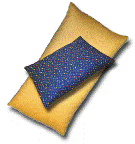Manage Temperature - Cold
When a person has orthostatic problems, their body often does not do well adjusting to different temperatures. They are sensitive to outside temperatures - like cold weather. With cold, blood flow to the hands and feet slows down. It can get pretty intense! They can turn pale, red or even blue.
 Cold Weather: The most obvious is to avoid it whenever possible. Then, dress in layers with the bottom layer a material that wicks sweat away from your body.
Cold Weather: The most obvious is to avoid it whenever possible. Then, dress in layers with the bottom layer a material that wicks sweat away from your body.
Dress in layers: if you start to get warm, too warm, you can take a layer off and not get too chilled. Stores that carry garments for cross-country skiing and other outdoor sports can help pick out materials and layering garments - like an undershirt, outer shirt, vest, windbreaker. They make them for different intensities of cold so you can pick the one that works for you. Don't forget wicking socks and thermal socks.
Hands and Feet: They can be especially vulnerable. Pick warm mittens or layers of mittens. Check out the "hand warmers" they make for people who spend long time in the cold, like ice fishing. They also make warmers for the boots. They don't usually cost much and are worth the money on those cold days when you have to go outside.
Getting Cold Just Sitting Around or Drinking Colder Drinks
 Sometimes, the body just gets cold. There might be a stages of getting cold:
Sometimes, the body just gets cold. There might be a stages of getting cold:
— your hands feel cold to someone else who touches them
— your hands feel cool to you
— your hands and whole body feel really cold.
The feet and hands might get red when they feel cold or pale. Some people get more blue/purple colors. They can also hurt, especially as they start to warm up. Some people have Raynaud's syndrome.
Put something warm on the outside of your body to help it warm up

AT HOME: The feet often get cold first. It can help to wear warm slippers. Once they're cold, you might need more outside heat to warm them up.
Warming pillows - filled with rice, buckwheat or dried corn - do a nice job. You control how hot they get, then they gradually cool down. You will often be warm enough by the time they cool off and you won't need to reheat them.
They are safer than warming pads. You control how hot they get by how long you put them in the microwave and then they start to cool. This protects you from skin burns. They also are safe if you fall asleep with one on your body. Some prefer the dried corn filling - it tends to have less of an odor when heated.
The fastest warming comes from putting something warm on the abdomen. That warms the blood in the center of the body, where most of it is! If you lie down, pull your knees up to your chest, most of your blood will be in the chest/abdomen.

Another option is to use a warming pillow around the neck.
TRAVELING: For most of us who don't have seat warmers in our cars, the warming pillows do a nice job. Use them at the start of the trip when the seats are cold or to warm your feet.
Warm the inside
Drink warm liquids. Drink warm liquids. Warm and not hot is better to help the body adjust. It takes a little while but if you use the outside warmers and liquids, it will start to make a difference.
Author: Kay E. Jewell, MD
Page Last Updated: September 7, 2012
